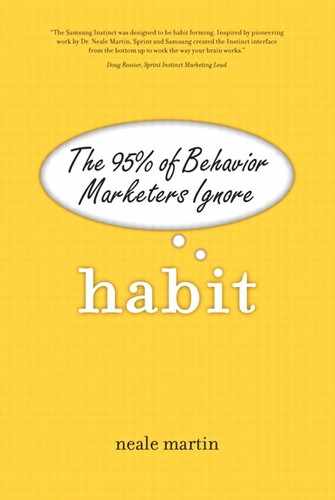Acknowledgments
Although only one author is listed on the cover, this book would not have been possible without the help and support of family, close friends, and old and new colleagues.
Kyle Morich served as researcher, editor, sounding board, critic, and cultural updater for the text. His advice to write the book like our conversations was the most valuable counsel I could have received.
Doug Rossier was my first corporate client to fully understand the implications of customers operating on unconscious habits. A senior manager at Sprint Nextel, he has become a relentless promoter of the habit framework across organizations.
Numerous experts across diverse fields provided the foundations for my understanding of the pervasive nature of habitual behavior. Any errors in interpretation or explanation are mine alone. Wendy Wood and David Neal, social psychologists at Duke University, were generous with their time and wisdom, explaining how habits trump intention in their experiments and in the real world. Jeff Quinn, a protégé of Wendy and David, was instrumental in pointing me in the right direction and providing ongoing critiques.
Russ Poldrack, cognitive psychologist at UCLA, provided not only extraordinary insights into the inner working of the mind, but also the limits of what is knowable using current technology. Similarly, Donald Norman of Northwestern shared his philosophies of product design and how the mind interacts with the world. His insights, shaped from decades of working with some of the world’s most innovative companies, were essential to connecting theories of the mind with marketplace realities.
I was surprised and delighted to discover that the man who had started me on midlife career change, Dr. Naresh Malhotra of Georgia Tech, had also become interested in the role of habitual behavior. He and Sung Kim of the University of Wisconsin (Madison) are examining how habits shape online behavior. They not only shared in their current research, but they also helped me develop a framework for my own research. I was also fortunate to be able to discuss the ideas of this book with Dr. Jagdish Sheth, one of the pioneers of customer behavior, my former employer, and a long-time friend.
Achala Srivasta took time out of her busy schedule to meet with me and explain how Nielsen Research is trying to uncover customer habits, a job much tougher than it sounds. She also shared many of the cross-cultural implications of habits from her years of global work experience. Harry West of Continuum Design and Harry Balzer of the NPD Group were also invaluable resources that gave me surprising insights that transcended their brief appearances in the book.
Karen Pryor, the noted animal behavioralist, helped me understand how the principles of dog training and habit training are essentially the same. She eloquently explained to me that positive reinforcement is not only the most effective, but also the most respectful way to work with people as well as animals.
Martha Cooley at Wharton Press/Financial Times saw the potential of the book and provided support from its earliest stages. Russ Hall provided encouragement, guidance, and feedback through the book’s various iterations. My agents at InkWell Management, Richard Pine and Alexis Hurley, also helped guide me through the complexities of the publication process.
This book began with the smallest germ of an idea after watching my daughter Miranda use her cell phone while sitting by the cordless house phone. According to her logic, she should receive the entire credit for this project. However, it would have been impossible for me to neglect my business and other responsibilities for the two years it took to research and write Habit without the support of my wife, Diana.
